Nonwoven fabric coated with a tetraphenylethene-based luminescent metal–organic framework for selective and sensitive sensing of nitrobenzene and ammonia†
Abstract
Luminescent metal–organic frameworks (LMOFs) are promising sensors in suspensions but efficient solid-state sensing devices based on LMOFs are rare. In this work, we synthesized two pillared-layered LMOFs [Zn2(TCPPE)(bib)] (1) and [Zn2(TCPPE)(bpy)] (2) based on tetraphenylethene (TPE)-based ligand [(H4TCPPE = 4-(4-carboxyphenyl)phenyl]ethene; bib = 1,4-di(1H-imidazol-1-yl)benzene; bpy = 4,4′-bipyridine). Complex 1 and activated 1 exhibited high fluorescence quantum yields (Φfl) of 46.3% and 35.3%, respectively. Activated 1 coated on nonwoven fabric by the hot-pressing method could maintain its structure and strong emission. The resulting activated 1@nonwoven fabric realized fast, selective and reversible sensing of nitrobenzene vapors with a maximum quenching efficiency of 90%. Interestingly, ammonia triggered an increase in luminescence intensity with a red-shifted emission of activated 1@nonwoven fabric, which is scarcely observed. Coating LMOF particles on a suitable fabric (e.g. nonwoven fabric) could be a feasible approach to create portable solid-state luminescence sensors for practical use.



 Please wait while we load your content...
Please wait while we load your content...